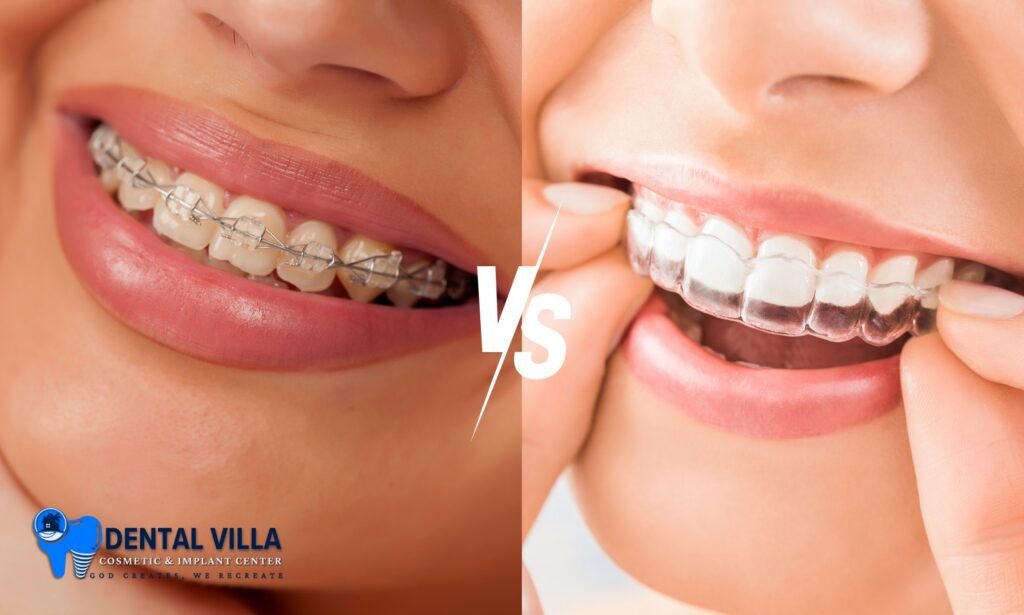Orthodontic treatment aims to correct misaligned teeth and jaws, improving both aesthetics and oral function. Traditional braces and clear aligners are the two primary methods used for orthodontic treatment. This blog explores the advantages, disadvantages, and indications for each approach to help you make an informed decision about which is right for you.

Conventional Orthodontics (Braces)
Conventional braces have been the gold standard in orthodontic treatment for decades. They consist of metal brackets attached to each tooth, connected by wires and rubber bands.
Advantages:
- Versatility: Braces can address a wide range of orthodontic issues, including complex cases with severe misalignment.
- Effectiveness: They have a proven track record of effectively straightening teeth and correcting bite problems.
- Affordability: Traditional braces are generally more affordable than clear aligners.
Disadvantages:
- Appearance: Metal braces can be noticeable and may affect self-esteem.
- Comfort: Braces can initially be uncomfortable, and they may require adjustments that can cause temporary discomfort.
- Oral Hygiene: Braces can make it more challenging to maintain good oral hygiene, as food particles can become trapped around the brackets and wires.
Indications for Conventional Orthodontics:
- Severe misalignment of teeth or jaws
- Complex bite problems, such as underbites, overbites, or crossbites
- Need for additional orthodontic appliances, such as headgear or palatal expanders
Contraindications for Conventional Orthodontics:
- Severe periodontal disease
- Untreated tooth decay
- Certain medical conditions that may interfere with treatment
Clear Aligners
Clear aligners are a relatively recent innovation in orthodontics. They are custom-made, transparent trays that gently shift teeth into alignment.
Advantages:
- Appearance: Clear aligners are virtually invisible, making them a more aesthetically pleasing option.
- Comfort: They are generally more comfortable than braces, with fewer restrictions on eating and speaking.
- Oral Hygiene: Clear aligners can be removed for brushing and flossing, making it easier to maintain good oral hygiene.
Disadvantages:
- Limited Effectiveness: Clear aligners may not be suitable for complex cases or severe misalignment.
- Cost: Clear aligners are generally more expensive than traditional braces.
- Compliance: Patients must wear aligners for the prescribed amount of time each day for optimal results.
Indications for Clear Aligners:
- Mild to moderate misalignment of teeth
- Desire for a more discreet orthodontic treatment
- Good oral hygiene habits
Contraindications for Clear Aligners:
- Severe misalignment of teeth or jaws
Need for additional orthodontic appliances

Beyond the Basics: Advanced Orthodontic Techniques
While traditional braces and clear aligners remain popular, advancements in orthodontic technology have introduced innovative techniques that offer more tailored and efficient treatment options.
Self-Ligating Braces
Self-ligating braces use a sliding mechanism instead of rubber bands to hold the archwire in place. This reduces friction and may lead to faster treatment times and improved comfort.
Lingual Braces
Lingual braces are placed behind the teeth, making them virtually invisible. They are suitable for patients who prioritize aesthetics but may require more complex adjustments and longer treatment times.
Clear Aligners with Attachments
Some clear aligner systems incorporate attachments, small plastic or metal pieces that bond to the teeth. These attachments can enhance tooth movement and address more complex orthodontic issues.
Invisalign iQ
Invisalign iQ is an advanced clear aligner system that utilizes artificial intelligence to predict tooth movement more accurately. This can potentially shorten treatment time and improve results.
Choosing the Right Orthodontic Treatment
The decision between conventional braces and clear aligners depends on various factors, including:
- Severity of misalignment: More complex cases may require traditional braces.
- Aesthetics: Clear aligners offer a more discreet option.
- Comfort: Clear aligners are generally more comfortable than braces.
- Lifestyle: Consider your lifestyle and commitment to wearing aligners as prescribed.
- Cost: Clear aligners are typically more expensive than traditional braces.
Additional Considerations
- Treatment Duration: Both conventional braces and clear aligners typically require 1 to 3 years of treatment. However, the duration can vary depending on the complexity of the case.
- Maintenance: After orthodontic treatment, it’s important to wear a retainer to maintain the results.
Frequently Asked Questions About Orthodontic Treatment
1. What is the difference between traditional braces and clear aligners?
Traditional braces use metal brackets and wires to straighten teeth, while clear aligners are custom-made, transparent trays that gently move teeth into alignment. Braces are generally more affordable but can be more noticeable and less comfortable. Clear aligners are more discreet and comfortable but may not be suitable for complex cases.
2. How long does orthodontic treatment typically take?
The duration of orthodontic treatment varies depending on the severity of the misalignment and the chosen treatment method. On average, traditional braces and clear aligners can take anywhere from 1 to 3 years. However, more complex cases may require longer treatment times.
3. Is orthodontic treatment painful?
Orthodontic treatment may cause some discomfort, especially during the initial adjustment period. However, the discomfort typically subsides within a few days. Modern orthodontic techniques, such as self-ligating braces and advanced clear aligners, can often be less painful than traditional braces.
4. How often do I need to visit my orthodontist for adjustments?
The frequency of orthodontic appointments varies depending on the treatment method and the complexity of your case. Typically, you will need to visit your orthodontist every 4-6 weeks for adjustments.
5. Can I still eat my favorite foods while undergoing orthodontic treatment?
You may need to avoid certain foods, such as hard, sticky, or chewy foods, while undergoing orthodontic treatment. However, with modern braces and aligners, dietary restrictions are generally less strict than in the past.
6. Will orthodontic treatment affect my speech?
Orthodontic treatment may temporarily affect your speech, especially during the initial adjustment period. However, your speech should return to normal as your teeth adjust to their new positions.
7. Can I still play sports while undergoing orthodontic treatment?
You can still play sports while undergoing orthodontic treatment. However, it’s important to wear a mouthguard to protect your teeth and braces from injuries.
8. What are the long-term benefits of orthodontic treatment?
Orthodontic treatment can improve your oral health, function, and appearance. Straight teeth are easier to clean, reducing the risk of cavities and gum disease. A well-aligned bite can also improve your chewing function and jaw joint health. Additionally, a beautiful smile can boost your confidence and self-esteem.
9. Are there any age restrictions for orthodontic treatment?
While orthodontic treatment is typically associated with children and adolescents, adults can also benefit from it. There is no age limit for orthodontic treatment, and many adults are choosing to straighten their teeth to improve their smiles and overall oral health.
10. How much does orthodontic treatment cost?
The cost of orthodontic treatment varies depending on the type of treatment, the complexity of the case, and your geographic location. Many insurance plans offer partial coverage for orthodontic treatment. However, it’s important to check with your insurance provider to determine your specific coverage.
Remember, these are just some of the most common questions about orthodontic treatment. If you have further questions or concerns, please don’t hesitate to consult with your orthodontist.
Dental Villa is committed to providing you with the highest quality orthodontic care. Schedule a consultation with our orthodontists today to discuss your orthodontic goals and explore the best treatment option for you.

